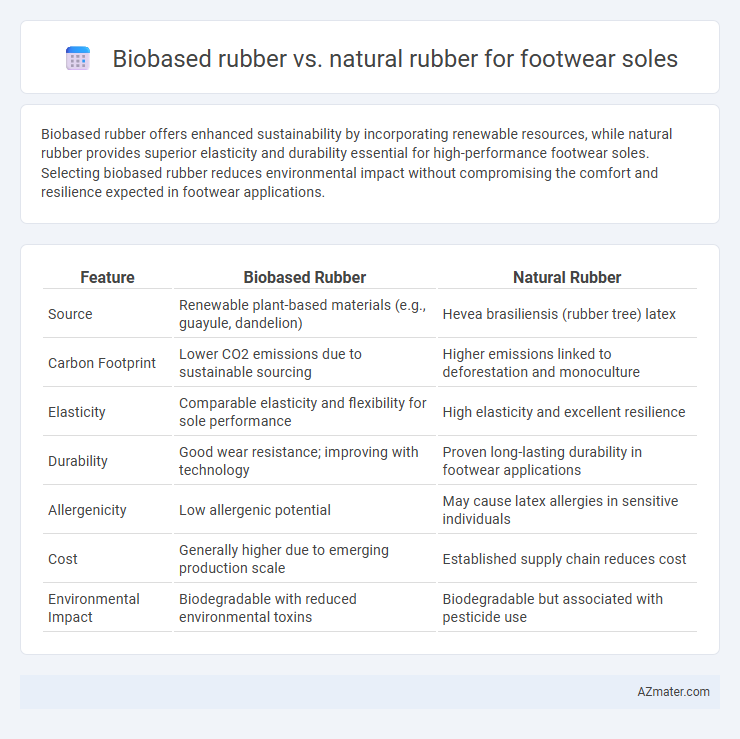Biobased rubber offers enhanced sustainability by incorporating renewable resources, while natural rubber provides superior elasticity and durability essential for high-performance footwear soles. Selecting biobased rubber reduces environmental impact without compromising the comfort and resilience expected in footwear applications.
Table of Comparison
| Feature | Biobased Rubber | Natural Rubber |
|---|---|---|
| Source | Renewable plant-based materials (e.g., guayule, dandelion) | Hevea brasiliensis (rubber tree) latex |
| Carbon Footprint | Lower CO2 emissions due to sustainable sourcing | Higher emissions linked to deforestation and monoculture |
| Elasticity | Comparable elasticity and flexibility for sole performance | High elasticity and excellent resilience |
| Durability | Good wear resistance; improving with technology | Proven long-lasting durability in footwear applications |
| Allergenicity | Low allergenic potential | May cause latex allergies in sensitive individuals |
| Cost | Generally higher due to emerging production scale | Established supply chain reduces cost |
| Environmental Impact | Biodegradable with reduced environmental toxins | Biodegradable but associated with pesticide use |
Introduction to Rubber Types in Footwear Soles
Biobased rubber and natural rubber are essential materials used for footwear soles, each offering distinct benefits. Biobased rubber is derived from renewable plant sources such as guayule or dandelion, providing sustainable alternatives with reduced environmental impact. Natural rubber, harvested primarily from Hevea brasiliensis trees, is prized for its high elasticity, durability, and excellent cushioning properties essential for comfortable and long-lasting shoe soles.
Defining Biobased Rubber and Natural Rubber
Biobased rubber is derived from renewable biological sources such as plant-based materials, offering an eco-friendly alternative to traditional rubbers. Natural rubber, obtained primarily from the latex sap of the Hevea brasiliensis tree, provides elasticity and durability essential for footwear soles. Both materials contribute to sustainable and high-performance footwear by combining environmental benefits with superior physical properties.
Raw Material Sources and Sustainability
Biobased rubber for footwear soles is primarily derived from renewable plant-based sources such as guayule, dandelion, and biomass feedstocks, offering a sustainable alternative to natural rubber sourced from Hevea brasiliensis trees. The cultivation of natural rubber often involves deforestation and habitat disruption, whereas biobased rubber reduces environmental impact by utilizing non-food crops and agricultural residues. Sustainability is enhanced in biobased rubber production through lower carbon emissions, improved resource efficiency, and potential for biodegradability compared to conventional natural rubber.
Processing and Manufacturing Differences
Biobased rubber for footwear soles involves sustainable raw materials like plant oils or bio-synthesized polymers, requiring specialized compounding and vulcanization processes distinct from traditional natural rubber. Natural rubber, derived from latex of Hevea brasiliensis, undergoes established processing methods including creaming, mastication, and sulfur vulcanization, optimized for elasticity and durability. Manufacturing biobased rubber soles often demands adjustments in mixing temperatures, curing times, and additives to achieve performance parity, impacting production efficiency and material consistency.
Environmental Impact: Biobased vs Natural Rubber
Biobased rubber for footwear soles significantly reduces carbon emissions due to its sustainable sourcing from renewable plant materials, unlike traditional natural rubber derived from rubber trees that contributes to deforestation and biodiversity loss. The production of biobased rubber involves less water usage and generates fewer pollutants, enhancing environmental sustainability compared to natural rubber plantations often associated with soil degradation. Choosing biobased rubber supports circular economy principles by enabling recyclability and biodegradability, minimizing long-term ecological footprints in footwear manufacturing.
Mechanical Properties and Performance
Biobased rubber offers enhanced mechanical properties for footwear soles, such as improved tensile strength and abrasion resistance compared to traditional natural rubber. Its higher elasticity and resilience contribute to better shock absorption, increasing overall comfort and durability under repeated stress. These performance advantages make biobased rubber a sustainable and efficient material choice for high-performance footwear applications.
Durability and Wear Resistance in Footwear
Biobased rubber for footwear soles offers enhanced durability and wear resistance compared to traditional natural rubber due to its modified polymer structure and proprietary additives. Its high abrasion resistance and resilience result in longer-lasting soles that withstand intensive daily use and varying environmental conditions. This makes biobased rubber an increasingly preferred material in sustainable footwear manufacturing focused on performance and longevity.
Cost and Market Availability Comparison
Biobased rubber for footwear soles typically incurs higher production costs compared to traditional natural rubber due to limited large-scale manufacturing and reliance on more specialized feedstocks like bio-synthetic polymers. Natural rubber remains more cost-effective and widely available in global markets, primarily sourced from rubber tree plantations in Southeast Asia, ensuring consistent supply chains for footwear manufacturers. Market availability of biobased rubber is still emerging, with gradual expansion driven by sustainability demand, whereas natural rubber benefits from established infrastructure and decades of commercial utilization.
Consumer Perceptions and Industry Adoption
Biobased rubber offers a sustainable alternative to natural rubber in footwear soles, attracting eco-conscious consumers who prioritize environmental impact and ethical sourcing. Industry adoption is growing as manufacturers integrate biobased materials to meet regulatory pressures and enhance brand reputation while maintaining performance standards. Consumer perception favors biobased rubber for its innovation and reduced carbon footprint, though natural rubber remains preferred for its proven durability and cost-effectiveness.
Future Trends in Sustainable Footwear Soles
Biobased rubber, derived from renewable resources such as guayule and dandelion roots, offers a sustainable alternative to traditional natural rubber sourced from Hevea brasiliensis trees. Innovations in biobased polymers and compounding techniques are enhancing the durability and performance of footwear soles while reducing carbon footprints and reliance on deforestation-prone rubber plantations. Future trends emphasize circular economy integration, with increased adoption of recyclable biobased soles and advancements in biodegradable formulations to meet growing consumer demand for eco-friendly footwear solutions.

Infographic: Biobased rubber vs Natural rubber for Footwear sole
 azmater.com
azmater.com